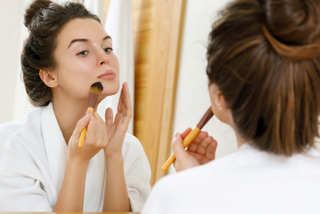
Is your foundation aging you, making you appear older than you actually are? Yikes! Bright orange foundation, cakey skin, two-toned faces and necks… as a sought-after makeup artist and esthetician for more than 30 years, I’ve truly seen every makeup mistake in the book—and I want to help you avoid these same mistakes.
The best foundation should enhance your natural beauty and help you achieve your most youthful glow, not age you in the wrong direction. Fortunately, there are a few easy ways to make your foundation work for you, not against you.
Your foundation may be aging you if…

#1: You’re not properly prepping your skin.
No matter your age, the number one contributing factor to a crappy foundation job is lack of skin prep. I may sound like a broken record, but it’s only because I can’t emphasize enough how critical it is to get your skin prep right before you move on to makeup. It's the most important thing! Do yourself (and your wallet) a favor and don’t waste money on expensive foundations without first appropriately prepping your skin.

"Do yourself (and your wallet) a favor and don’t waste money on expensive foundations without first appropriately prepping your skin. "
There are endless skincare benefits to a good skin prep routine (soothe irritation! minimize the appearance of pores! prime skin!), and a smooth makeup look is one. Dehydrated skin is the enemy of a good foundation application, and tending to that issue should take priority. For more mature skin, skin prep is absolutely essential to minimize signs of aging. Our entire line of skin prep is not only gentle, but effective in keeping skin hydrated, supple, and smooth—the perfect partner for a luminous finish. For step-by-step skin prep instructions, read my ultimate guide on how to layer skin prep before makeup.

#2: You don't have the right foundation texture.
NEWS FLASH: Your skin loses collagen as you get older, which can change the appearance of your skin texture. That means the foundation that was a perfect fit for you in your 20s ain’t gonna cut in in your 50s. Foundation with the wrong texture can bring out fine lines and wrinkles. Skin’s natural, healthy state has a sheen to it, and you have to match the skin texture to the texture of the formula.
Some women think they are opting for a good, full-coverage foundation when really they are selecting a thick formula that looks and feels heavy on the skin. Full coverage foundations are generally the most aging because they contain more pigment (which is basically powder mixed with water). Instead, choose a more sheer foundation that can be layered in areas where you want more coverage. This will help achieve a more natural finish, especially for older skin.

Typically, matte foundations don’t do any favors for dry skin. Likewise, a powder foundation—or too much setting powder—may end up settling in fine lines and draw attention to wrinkles (even if you have oily skin). A BB cream or tinted moisturizer may be a solution, but light, full coverage foundations do exist! You’ll likely want to be on the hunt for a lightweight formula with extra hydration for a dewy, glowy (but never greasy!), radiant finish. Of course, the perfect foundation will depend on your skin type, tone, and personal preference.
PRO TIP: I’ve said it before, but it’s worth repeating: Skin prep is a MUST with any liquid foundation (really any makeup product) but it is REQUIRED to use with stick foundation.

#3: You’re applying too much.
Less is sometimes more, as they say. Often, women who want to cover dark spots, sun damage or age spots slather on a thick layer of heavy foundation—but it can have the opposite effect. Unless you’re making your debut in a stage production of “Cabaret,” avoid the temptation to slap on copious amounts of foundation in the effort to mask imperfections. In the case of foundation, a heavy hand will give you the opposite result and look cakey and chalky—not what we want!
This is why buildable coverage is a good choice that allows for layering without pilling. Sure, this may take more time, but it’s not worth it to rush. And, if dark spots and discoloration are bothersome, lasers are effective at getting that under control. The better the skin, the better the foundation.
In the case of foundation, a heavy hand will give you the opposite result and look cakey and chalky—not what we want!
Your application technique makes a huge difference, too. You want to work in light layers. Start with a small amount and blend, blend, blend with feather-light strokes. Pay extra attention to the edges around your hairline, jaw and ears—the last thing you want is a tell-tale line that screams “Makeup stops here!”
One trick I love is to thin out too-thick formulas using my Water Elixir. This can instantly transform a stiff, thick foundation into something more blendable and buildable.

#4: You’re applying the wrong color foundation.
Sometimes, the solution to a better foundation is as simple as switching shades. The perfect shade match can feel like finding a needle in a haystack, though. Too pale and you risk looking sickly; too warm and you’ll look like an oompa loompa. Make sure to test out your shade near your jawline as well as your wrist—not just on your forehead or back of your hand.
In some cases, a foundation formula will oxidize when it’s melded with your natural face oils over the course of a few hours. The right primer should eliminate this issue (helllllooooo, Water Balm!).
PRO TIP: Use SexApeel™ Instant Exfoliation Spray before you shop for or try out a new foundation. You’ll be able to actually see the proper color once you’ve gotten all that dead skin off your face, which may otherwise distort the undertones of your skin.

#5: You’re using bad lighting.
At the risk of sounding like a diva, just say no to unflattering lighting! This is about more than just finding your best angle—the wrong light can totally change the way you perceive foundation color, face shape, and contour.
Harsh fluorescent lights are arguably the most unflattering light for makeup application. If you’ve ever applied makeup in a hotel bathroom, then walked out in front of a window to assess your work, then you know what I’m talking about. I love an LED lighted mirror, but it’s a mistake to apply foundation in a super-zoomed setting without stepping back every so often to see how it looks.
The easiest way to get the best light is to position your vanity directly in front of a flood of natural light. Since that’s not always realistic, it's a good idea to shoot for warm, natural light as much as possible. Plus, you need my secret weapon: The Makeup Light. Yes, it’s an investment, but it’s worth every penny.

Hopefully, this beauty advice will prevent your foundation from prematurely aging you and help you find the perfect match. On the hunt for your new favorite foundation? Don’t miss my guide: My Favorite Foundations for Over-40 (With Sensitive Skin).
Nailed your foundation, but not so sure about your concealer? Watch this 13-minute Concealer Makeup Tricks video featuring everything you need to know.
Do you think your foundation makes you look older than you are? Let me know in the comments!






